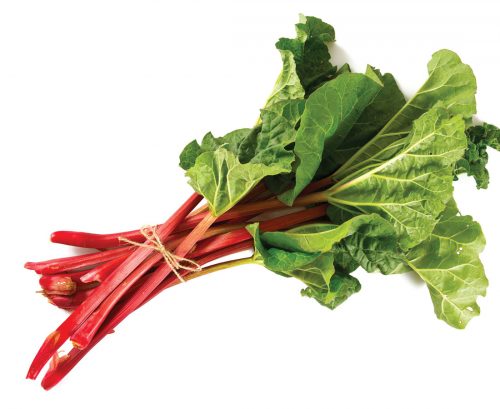
Cherry red rhubarb
Rhubarb is native to China and was used for its medicinal properties. Interestingly, rhubarb stalks were only recently recorded being used as a food in 18th to 19th century England.
It’s common knowledge that the leaves of the rhubarb plant are very toxic to both humans and animals, so when preparing ensure that only the stem is eaten.
This vegetable is often mistaken for a fruit due to its sweet flavouring and that it’s often used in dessert. Gardeners and bakers might assume that deep red rhubarb has the sweetest flavour. However, the colour of rhubarb actually has very little to do with its flavour.
While it can be baked into pies, muffins and trifles, it also goes surprisingly well with pork and chicken and can also accompany your morning porridge.
Rhubarb is high in fibre with just ¹/³ cup of cooked rhubarb providing 2g fibre.
Recipes
Mary Washington asparagus
If you’re hoping to plant and harvest asparagus within the same year, it will come as a surprise that this vege can take up to four years before harvesting edible spears but can continue to produce for over 10 years.
This vege tends to fly off the shelf when it arrives because, for many, asparagus signifies the start of spring.
Unsure about how old your asparagus is? Rub the stalks and if it is fresh it should squeak. If you don’t manage to use all your asparagus in one meal, it can be stored in the fridge with cut ends covered in a moist paper towel.
Most commonly seen alongside salmon as a dish, asparagus can also be incorporated into breakfasts, pies, salads and fritters.
A serve of asparagus, around six spears, adds 1.6g fibre and nearly one-third of our daily recommended dietary intake of folate. Asparagus also contains sulphur compounds that, for some people, can affect the smell and colour of urine.
Recipes
Spring salad with asparagus, goats’ cheese and hazelnuts
Courgette, asparagus and basil quiche
Fresh this month
Harvested in New Zealand gardens in October
Vegetables
Broccoli, cabbage, cavolo nero, celeriac, chilli, cauliflower, courgette, leek, lettuce, mushrooms, onion, parsnip, potatoes (new season), pumpkin, radish, rocket, silver beet, snow peas, spinach, spring carrots, spring onions, swede, watercress.
Herbs
Chives, coriander, dill, marjoram, mint, oregano, parsley, rosemary, sage, thyme.
Fruit
Avocado, kiwifruit, lemon, lime, navel oranges, tangelos.
www.healthyfood.com










